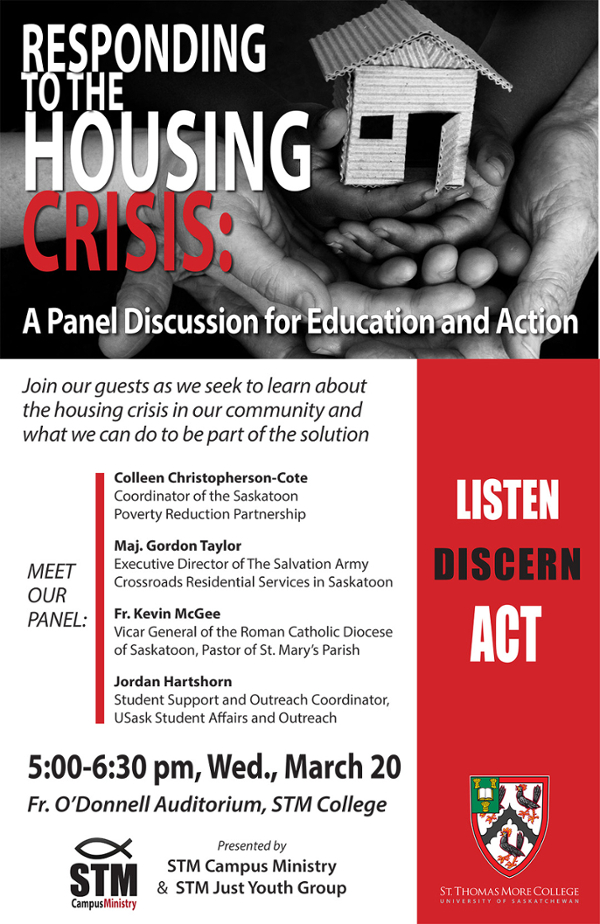
Panelists highlight challenges Saskatoon faces in ongoing housing crisis
STM Campus Ministry, Just Youth host Panel Discussion for Education and Action
By Paul Sinkewicz
“This is a complex issue. We won’t be solving it today. But hopefully we will leave this space with more information, a better sense of direction, and empowered toward action,” said Celeste Woloschuk at the start of evening of discussion focused on homelessness and housing insecurity.
Woloschuk, a Campus Minster at St. Thomas More College, and Shekinah Vallada, student leader in the STM Just Youth club, moderated the discussion on March 20.
Titled Responding to the Housing Crisis: A Panel Discussion for Education and Action, the event featured panelists with expertise in the challenges facing the city.
They were given questions to reflect upon, with the audience given the chance to ask follow-up questions later in the discussion.
“As we enter into this conversation today, we all must recognize that the issues we will be discussing are sensitive and complex,” said Woloshuk. “The conversation in our city has been going on for a long time, and it hasn’t always been an easy conversation.”
She asked the room to bring a spirit of respect and compassion to the discussion.
The first panellist was Colleen Christopherson-Cote, Co-ordinator of the Saskatoon Poverty Reduction Partnership. She brought more than 20 years of experience working in social and economic development in both rural and urban communities in the province to the talk.
Christopherson-Cote said 16 per cent of the population of Saskatoon lives in poverty, and the city currently has the lowest minimum wage in Canada.
“When we start thinking about closing our eyes and picturing who is living in homelessness situations, we don’t often picture folks who are working.”
She said there are more people precariously housed and teetering on homelessness than are reflected in a lot of data on poverty and homelessness.
Maj. Gordon Taylor, Executive Director of the Salvation Army Crossroads Residential Services in Saskatoon, is responsible for a 75-bed emergency shelter, a 25-bed correctional halfway house, a transitional group home for youth, transitional housing for men, emergency after-hours assistance, and an overnight winter warming centre.
He said one of the initiatives the Salvation Army is working on right now is creating a continuum of care that goes past emergency shelters that can lead to some kind of secure, stable housing.
“Shelters aren’t a solution. They are a stop-gap, temporary solution,” said Taylor.
The Salvation Army has internal housing case workers who try to work with their clients to find the next step toward security. That can lead some of the men to a two-year transitional home operated by the charity.
Fr. Kevin McGee, Vicar General of the Diocese of Saskatoon and Pastor of St. Mary’s Parish, spoke about his parish’s new program to help ease suffering during the coldest months of the year.
The St. Mary’s Parish hall has been hosting an overnight warming centre this winter in partnership with the Salvation Army.
After the parish was approached about the possibility of hosting an all-night warm up centre seven days a week for the entire winter, he brought it to the parish community. It was a big request, he noted, and all voices needed to be heard.
“And that prompted a discernment process,” Fr. McGee said.
With a spirit of openness to finding out God’s will, and after much listening, discussion and prayer, the parishioners leaned into the challenge and opened up the doors to their hall.
“What brought us to this reality is that we live in the neighbourhood where we see that need daily.”
Of course, the problem of homelessness and housing insecurity in Saskatoon were not solved at the event, as predicted. But the evening prompted great discussions and increased the knowledge of all who attended, said co-moderator Vallada.
The second-year student got involved in the Just Youth program through her sociology class, which offered the chance to volunteer in the STM Community Service Learning project.
She was attracted to it because it offered the chance to work on issues and events that could have an impact on USask and the wider community.
She has plans to work toward her degree in nursing, and will stay involved in STM Just Youth next year.
“I was so glad to participate in this event,” said Vallada. “It’s a very serious topic in Saskatoon. I learned a lot, personally.”
